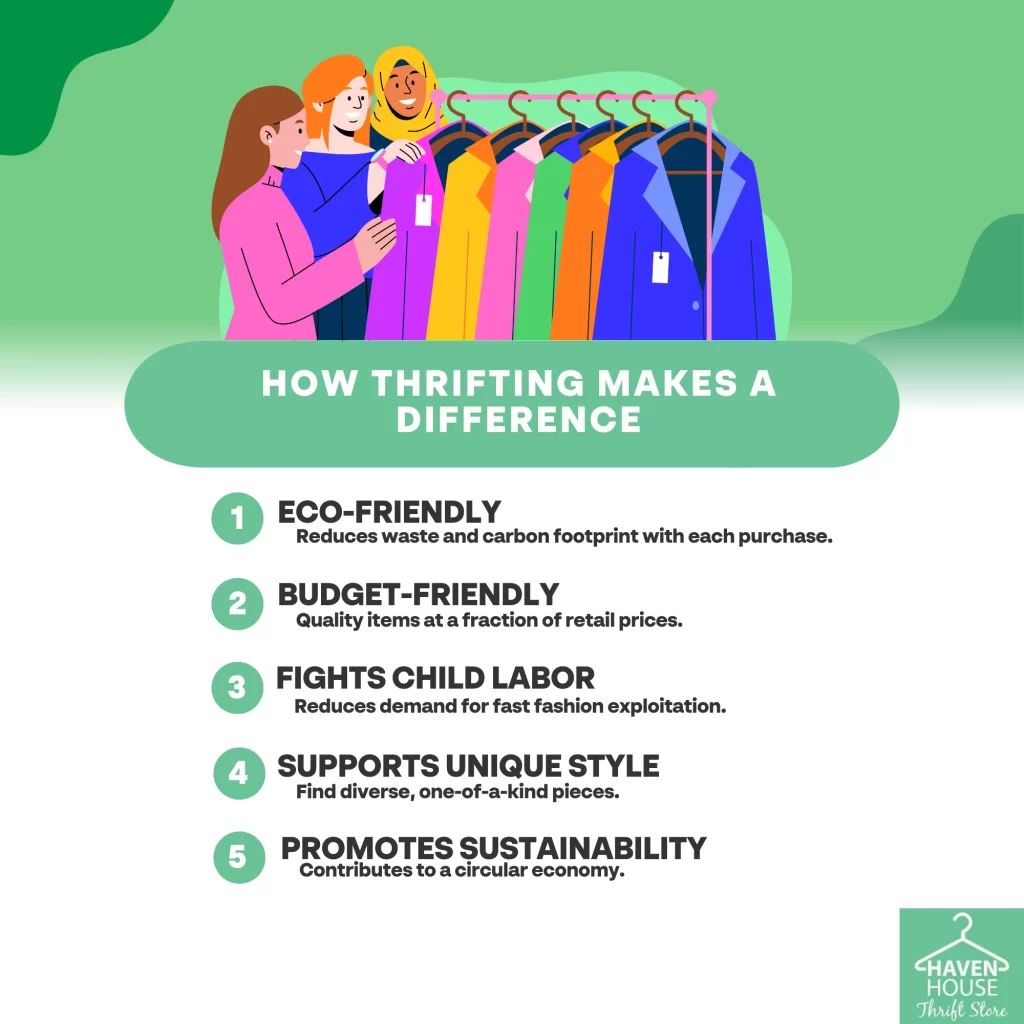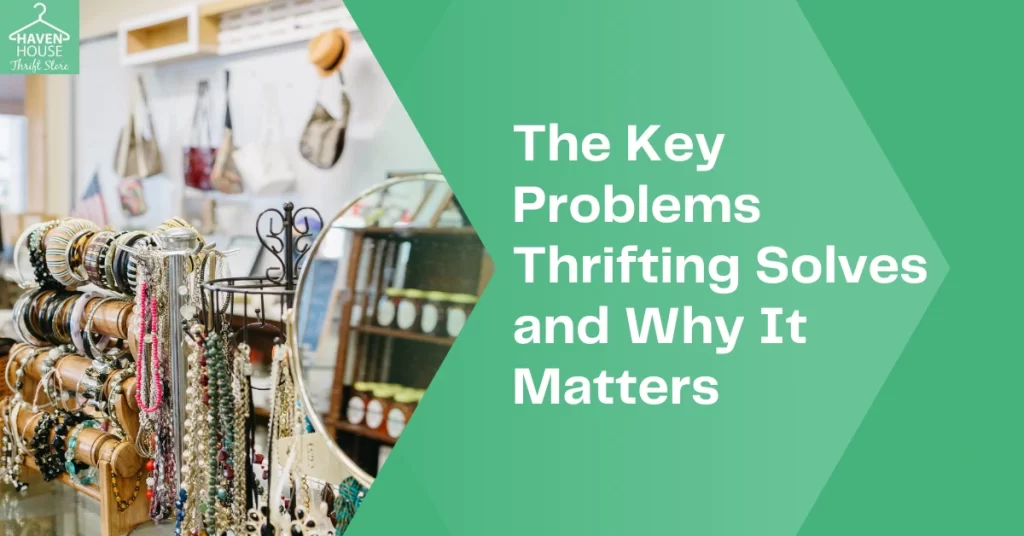Thrifting brilliantly solves key issues you probably engage with daily. It’s eco-friendly, reducing landfill waste and the carbon footprint associated with new item production. By repurposing, you help lessen the mammoth 10% global carbon emissions from the fashion industry. Additionally, it’s a wallet-friendly lifestyle choice, offering quality goods at a fraction of retail prices. Thrifting also combats child labor, reducing demand for cheap labor in the fast-fashion industry. Plus, it’s a gateway to novel style domains, fostering creativity and self-expression. There is much more to the thrifting world waiting to be unraveled, making every second-hand purchase an impactful decision.

Key Takeaways
- Thrifting significantly reduces environmental impact by lowering carbon emissions and decreasing landfill waste from the fashion industry.
- It offers an affordable alternative to retail shopping, allowing consumers to save money without compromising on quality or style.
- Thrift shopping helps combat child labor and exploitation by reducing demand for new clothes from fast fashion brands.
- It encourages personal style development, providing diverse and unique clothing pieces that promote creativity and individuality.
- Thrifting promotes a circular economy, keeping textiles in use longer and reducing the demand for new production.
Bettering The Environment
Countless shopping bags are saved from entering landfills when you choose to buy from thrift stores, greatly bettering the environment. This simple act notably reduces your carbon footprint. Each item you purchase second-hand means one less new item produced.
According to a report by the Ellen MacArthur Foundation, the fashion industry produces 10% of all humanity’s carbon emissions. By shopping thrift, you’re directly combating this issue. You’re not just saving clothes from landfills; you’re reducing the demand for new clothing production, which carries a heavy environmental cost.
Furthermore, the Council for Textile Recycling estimates that the U.S. generates an astonishing 25 billion pounds of textiles per year. That’s about 82 pounds per person! Sadly, only 15% of this gets donated or recycled, while the rest — 21 billion pounds — ends up in landfills.
Shopping at thrift stores can notably dent these numbers. However, it’s not just about shopping. Donating your used clothing is equally essential. This creates a circular economy, keeping textiles in use and out of landfills.
Reduces Clothing Costs For Shoppers
Shopping at thrift stores can considerably reduce your clothing costs. Instead of purchasing new, often overpriced items, you’re able to find high-quality, gently used clothing at a fraction of the retail price. According to research, regular thrift store shoppers can save up to 70% off retail prices.
Moreover, thrifting promotes a sustainable lifestyle. By choosing to buy secondhand, you’re not only saving money but also reducing the demand for new clothing production, which often involves harmful environmental practices and excessive resource consumption.
Thrift stores offer a wide range of brands, styles, and sizes, providing options for a diverse consumer base. As a shopper, you can refresh your wardrobe more often without breaking the bank, which can be especially beneficial for those on a tight budget.
Lastly, the money saved from thrifting can be allocated towards other essential expenses, savings, or investments. In this way, thrifting isn’t just a cost-effective way to shop, but a financial strategy that can enable you to manage your resources better.
It’s a win-win for your wallet and the planet.
Reduces Child Labor
Often, we overlook the fact that the clothing industry is one of the major contributors to child labor globally. Fast fashion brands, in their quest for cheap production, often exploit vulnerable communities, leading to widespread child labor.
However, when you choose to thrift, you’re taking a stand against such nefarious practices. Thrifting markedly reduces the demand for new clothes, thereby reducing the need for cheap labor. Consequently, it diminishes the chances of children being exploited in sweatshops.
Here’s how:
- You’re not supporting industries that exploit child labor.
- Lower demand for new clothes means less production.
- Less production means fewer sweatshops employing children.
- Ultimately, you’re contributing to a reduction in global child labor.
Choosing to thrift isn’t just about saving money or being environmentally friendly. It’s about human rights too. It’s about ensuring that the clothes you wear aren’t a result of a child’s suffering.
Helps You Find Your Style
In maneuvering the world of thrift shopping, you’re inevitably opening a door to unique, diverse, and timeless pieces. This treasure trove of clothing offers an unparalleled opportunity to carve out your personal style. You’re not confined to current trends or seasonal collections. Instead, you have the freedom to mix and match, creating looks that truly reflect your personality.
Research shows that thrift shopping can enhance your creativity and problem-solving skills as you hunt for items, imagine potential outfits, and make alterations. A study conducted by the Journal of Consumer Behaviour found thrift shoppers to be more innovative when it comes to fashion.
They’re not just consumers; they’re curators of their own style.
Moreover, thrifting is an inherently sustainable choice. As you consciously opt for secondhand items, you’re reducing demand for fast fashion, consequently contributing to a circular economy and reducing environmental impact.
Frequently Asked Questions
What Recovery Programs Do the Thrift Store Proceeds Support?
You’re supporting recovery programs like Haven House Addiction Recovery when you shop or donate at these thrift stores. Your contributions directly fund services, aiding individuals in overcoming addiction and enhancing community resources.
How Can I Donate Items to These Thrift Stores?
You can donate items to these thrift stores by dropping them off at any location. They’ll appreciate your contribution, as it supports community initiatives and helps fund recovery programs. Your donations matter, so thank you!
What Type of Items Can I Find at These Thrift Store Locations?
At these thrift stores, you’ll find a variety of items. From clothing and accessories to furniture and household goods, there’s something for everyone. It’s a treasure trove where every purchase supports local community initiatives.
How Does the Thrift Store in Destin, FL Contribute to Haven House Addiction Recovery?
You’ll find that the Destin, FL thrift store directly supports Haven House Addiction Recovery. It’s through your purchases and donations there that they’re able to fund and maintain their essential recovery services.
Can I Shop and Donate at the Thrift Stores in Lebanon and Carthage, TN?
You can shop and donate at the thrift stores in Lebanon and Carthage, TN. Your contributions will not only find new homes but also support Haven House’s addiction recovery initiatives. It’s a win-win!
Conclusion
So next time you’re thrifting, remember it’s not just a treasure hunt. It’s a step towards a greener planet, a stand against child labor, a way to ease your wallet, and a journey of self-expression. Like the proverbial stone killing multiple birds, your act of thrifting tackles pressing issues. It’s the ripple effect of goodwill that starts with you. So, thrift on, knowing you’re making a difference, one bargain at a time.

